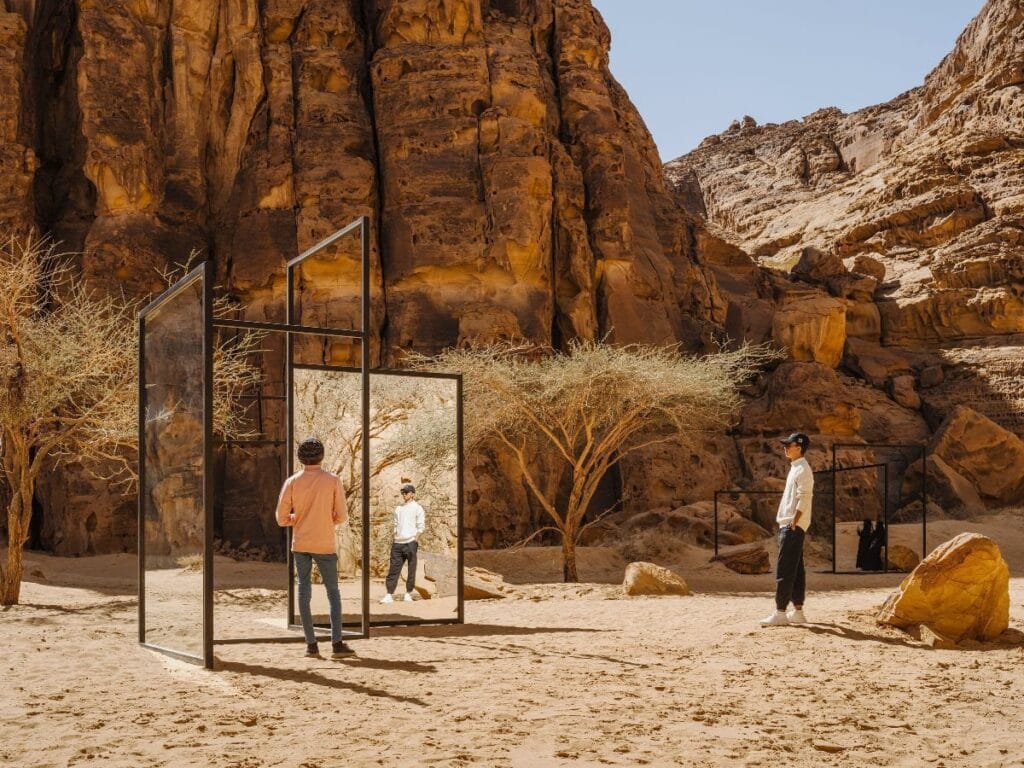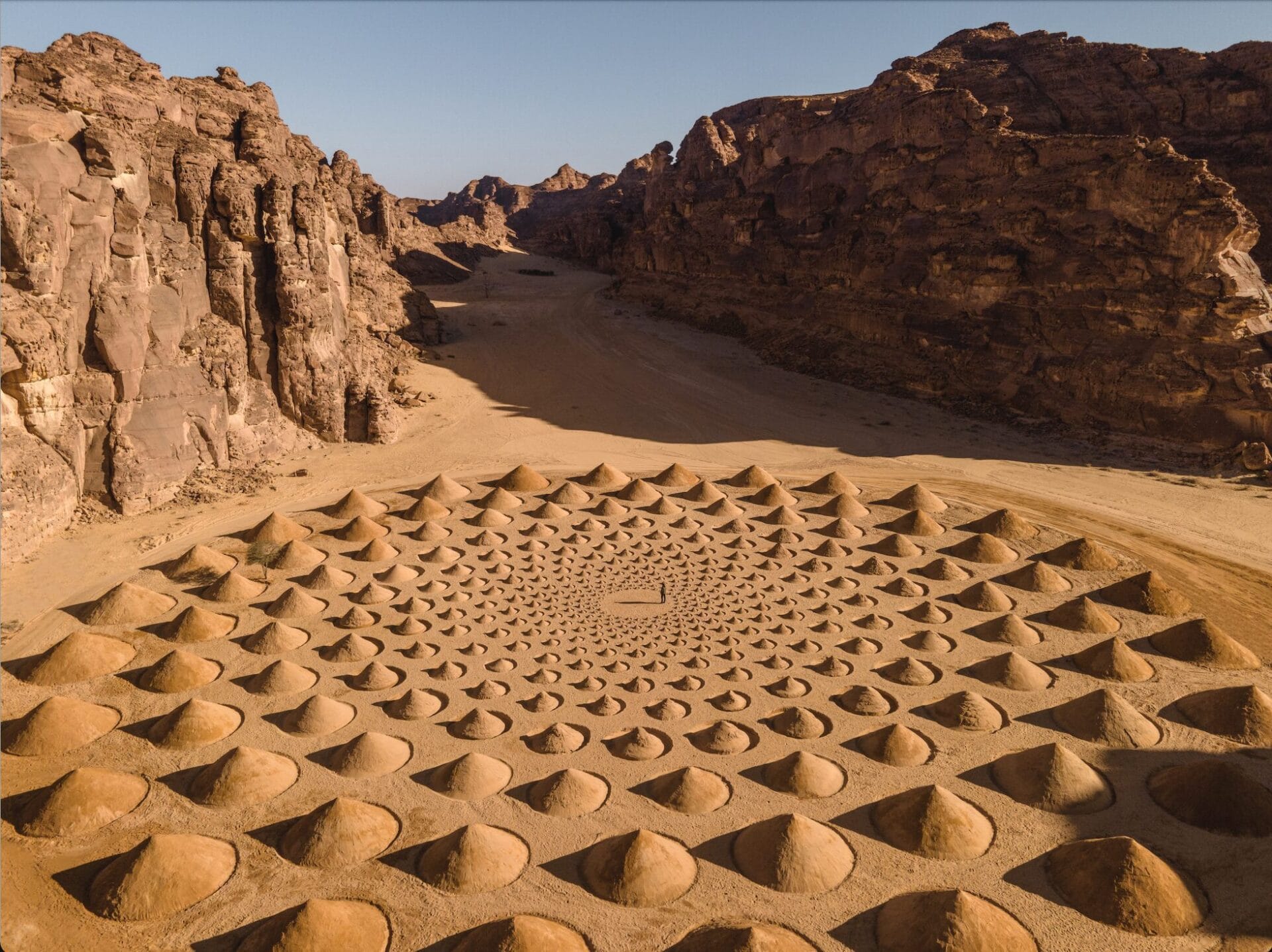DESERT X ALULA 11 FEBRUARY – 30 MARCH 2022
SECOND EDITION OF INTERNATIONAL ART EXHIBITION FEATURES 15 ARTISTS EXPLORING IDEAS OF MIRAGE AND OASIS UNDER THE THEME SARAB
FREE AND OPEN TO ALL, DESERT X ALULA IS A RECURRING, SITE-RESPONSIVE, INTERNATIONAL ART EXHIBITION TAKING PLACE IN ALULA, A GLOBALLY SIGNIFICANT ANCIENT DESERT REGION IN THE ARABIAN PENINSULA. THIS YEAR’S EXHIBITION, UNDER THE CURATORIAL VISION OF REEM FADDA, RANEEM FARSI AND NEVILLE WAKEFIELD, FEATURES NEWLY COMMISSIONED WORKS BY 15 ARTISTS BRINGING A PLURALITY OF VOICES FROM AROUND THE WORLD.
Following its inaugural exhibition in 2020, Desert X AlUla returns for its second edition from 11 February – 30 March 2022, placing visionary contemporary artworks by 15 Saudi and international artists amidst the extraordinary desert landscape of AlUla, a majestic region in north-west Saudi Arabia of natural and creative heritage steeped in a legacy of cross-cultural exchange.
Under the theme of Sarab, this year’s exhibition explores ideas of mirage and oasis, both intrinsic to desert history and culture, that have taken on complex worldwide significance over time. Invited to consider these ancient concepts, participating artists have responded with new works that address dreams, camouflage, fiction, dis/appearance, extraction, illusion and myth, while also examining the dichotomy between the natural and man-made worlds.
The exhibiting artists are:Shadia Alem, b. Saudi Arabia, based in Paris.Dana Awartani, b. 1987, Saudi Arabia, based in Jeddah.Serge Attukwei Clottey, b. 1985, Ghana, based in Accra.Claudia Comte, b. 1983, Switzerland, based in Basel.Shezad Dawood, b. 1974, United Kingdom, based in London.Jim Denevan, b. 1961, United States, based in Santa Cruz.Stephanie Deumer, b. 1989, Canada, based in Los Angeles.Sultan bin Fahad, b. 1971, Saudi Arabia, based in Los Angeles.Zeinab Alhashemi, b. 1985, United Arab Emirates, based in Dubai.Alicja Kwade, b. 1979, Poland, based in Berlin.Shaikha Al Mazrou, b. 1988, United Arab Emirates, based in Dubai.Abdullah AlOthman, b. 1985, Saudi Arabia, based in Riyadh.Khalil Rabah, b. 1961, Palestine, based in Ramallah.Monika Sosnowska, b. 1972, Poland, based in Warsaw.Ayman Zedani, b. 1984, Saudi Arabia, based in Riyadh.
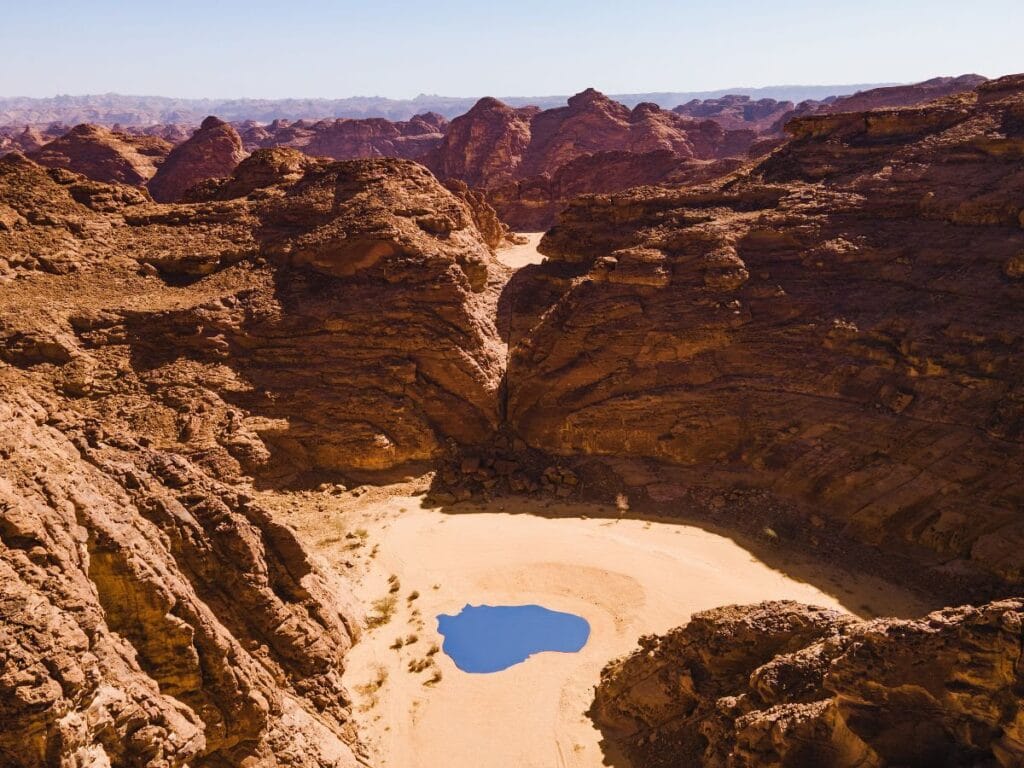
Desert X AlUla is a collaboration between Desert X and the Royal Commission for AlUla (RCU) established to advance new cultural dialogue through art. The first site-responsive exhibition of its kind in Saudi Arabia, it fosters dialogue and exchange between artists, curators and international and local communities, shaped by a curatorial vision that takes the desert as its inspiration. Building on the legacy of Desert X, which takes place in California’s Coachella Valley, Desert X AlUla draws on principles of land art, offering a profound opportunity to experience art on a monumental scale in dialogue with nature.
This year’s exhibition takes place in a different location in AlUla to the previous edition, situated in the Al Mutadil valley, with visitors invited to wander through and experience spectacular landscapes as they weave their journey between the works.
Shadia Alem’s sculptural installation adapts the art of origami, applying the basic principles of geometry and beauty to create shapes that make reference to the Arabian desert’s literature, mathematics and mythology. Dana Awartani’s sculpture draws inspiration from the vernacular architecture of AlUla, taking the form of a concave geometric sculpture that references the Nabataean tombs and mimics the shapes of surrounding mountains, gorges, caverns and rock formations.
Serge Attukwei Clottey’s installation addresses the experience of globalisation, migration and water equity by shrouding slabs of rock in meticulously crafted tapestries made from yellow kufuor gallons, which are plastic containers used in Ghana for storing and transporting water. Claudia Comte’s work features a progression of walls imposing their architectural presence within the natural order of the AlUla canyons, with each carrying a section of a larger algorithmic pattern relating to the waveforms that shape the sound and surface of the desert.
Shezad Dawood’s work explores ideas of deep time and the geo-biological relationship between the desert floor and nearby Red Sea through a pair of coral-like forms whose temperature-sensitive surfaces reflect the effects of climate change and mankind’s continuing struggle to find a sustainable relationship with a rapidly changing ecosystem. Land artist Jim Denevan creates ephemeral drawings whose interlocking patterns speak to the shifts in magnitude and scale that so often shape our experience of the desert and our attempts to position ourselves within the vastness of unbounded space.
Working at the intersection of nature and technology Stephanie Deumer has created an underground greenhouse; hinting at the lush sanctuary of native plants below, a large puddle-shaped array of solar panels mounted flush with the desert floor creates an energy feedback loop where the energy of the sun is captured, stored and transformed through photosynthesis into growth and transformation. Sultan bin Fahad’s mud structure is shaped like a desert kite, with mirrors on the façade that create the look of a mirage, and houses an urn-like sculpture embossed with four protective symbols traditionally used in Nabatean tombs.
Zeinab Alhashemi’s interactive sculpture uses discarded camel skins on an abstract, geometric base, resembling a rock formation in the desert; like a camouflage, these camel hide sculptures merge into the mountains. Alicja Kwade’s architectural structures reflect and frame the natural artefacts she encountered on the desert floor, which she rearranged and supplemented to create constantly changing perspectives that strike the fine line between reality and illusion. Shaikha Al Mazrou’s lengthy steel-made inflated structures are wedged in the voids of rocks, tensely balanced in the landscape, occupying the liminal state between stasis and movement, creating a silent yet imposing composition suspended in inertia.
Abdullah AlOthman’s piece references theories of light refraction rooting back to the early days of desert civilisation and culture, with stainless steel plinths that interact with the light and create a radiant space that seeks to manifest the experience of capturing the mirage for the first time. Khalil Rabah creates a mirage of an orchard of olive trees, which stand here in the desert as living things displaced from their indigenous land and longing to be repatriated, as an exploration of territory, survival and citizenship.
Monika Sosnowska’s sculptural exploration of memory speaks to AlUla’s historical position as a hub and passage of trade and its more recent cultural re-awakening; using heritage rails from the Hejaz railway, that ran from Damascus to Medina, the linear steel forms have been transformed into giant dried grasses replete with possibilities of growth and transformation. Ayman Zedani’s soundscape installation in a rocky cavern comprises horizontal sculptural wires and an audio projection of music, voices and footsteps, creating a cacophony of sounds that add to the chimes of nature.
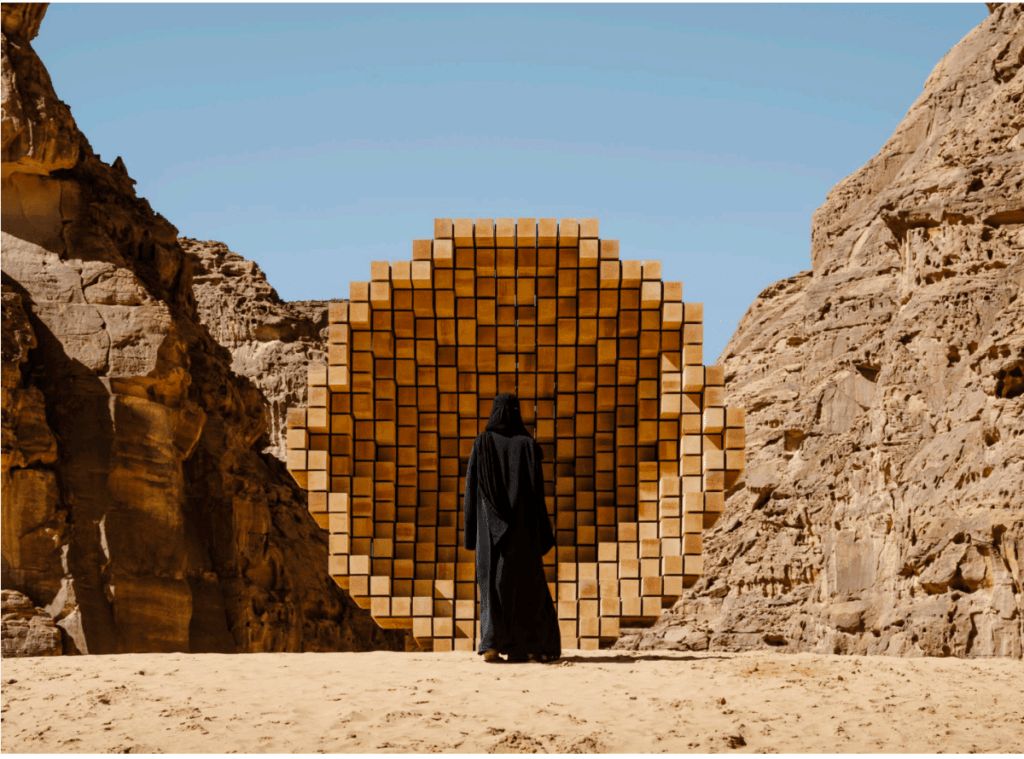
Desert X AlUla aims to contribute to and continue the artistic heritage of the local community and region: works from the 2020 edition by Lita Albuquerque, Manal AlDowayan, Sherin Guirguis, Mohammed Ahmed Ibrahim, Nadim Karam and Superflex remain in place in AlUla, on view from sustainable hotel Habitas, while Rashed AlShashai and Muhannad Shono were selected to work as part of AlUla’s first artist residency, an 11-week programme whose final exhibition, The Oasis Reborn, is on display in the palm grove of Mabiti until 31 March. Likewise, the ongoing collaboration provides an international platform for Saudi artists: Zahrah Alghamdi, whose work Glimpses of the Past was presented in the inaugural Desert X AlUla, went on to exhibit her work What Lies Behind the Walls to critical acclaim at Desert X 2021 in California.
Home to the UNESCO World Heritage Site, Hegra, built by the Nabataeans over 2,000 years ago, the AlUla region has been at the crossroads of cultural exchange for millennia, historically lying on the incense trade route and once capital to the ancient Kingdom of Dadan. Today, it is a living museum of heritage, arts and nature, rekindling its legacy as a vital cultural destination. By reimagining the boundaries of creativity and ingenuity, AlUla aims to share the transformative power of the arts through the prism of AlUla’s legacies, character and ambition.
As part of AlUla’s wide-ranging local community engagement and education programme that aims to reinvigorate a vibrant cultural economy, Desert X AlUla 2022 includes art mediator training programmes, family events, workshops for teachers and other networking and programming activities for visitors and communities, including site-specific, newly commissioned dance and music performances. For more details on these activities please click here.
Desert X AlUla takes place as a highlight of AlUla Arts Festival, which also includes ‘What Lies Within: Works from the Basma AlSulaiman Collection’ (11 February – 20 March), an exhibition at Maraya of seminal works by contemporary Saudi artists, including Shadia Alem and Dana Awartani, exhibited for the first time in Saudi Arabia. This exhibition, curated by artist Lulwah AlHomoud, marks the first in a series of shows in AlUla featuring pioneering collectors and patrons.
During the festival, AlJadidah Village, an area adjacent to AlUla Old Town, will be a vibrant hub of activity and performances, with the outdoor Cinema El Housh presenting Saudi arthouse filmmakers. Between February and March, the first edition of a collaboration with Italy’s Cortana On The Move festival of visual narratives takes place, presenting cutting-edge photography in AlUla, with works from the Cortana festival exhibited alongside works by Arab artists, curated by Arianna Rinaldo and Kolhood Albakr.
With a view to the future, as detailed in AlUla’s ‘Journey Through Time’ masterplan, AlUla Old Town adjoined by the Cultural Oasis will develop into one of five districts and serve as a nexus of community, cultural production and artistic explorations. By 2035, the masterplan will see 15 new landmark destinations for culture, heritage and creativity open in AlUla.
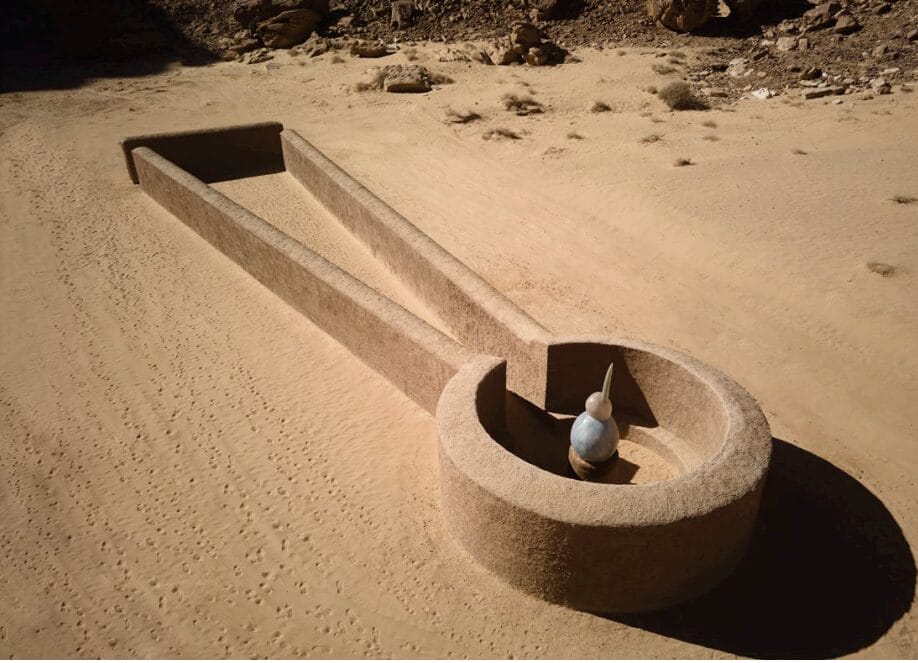
Reem Fadda, curatorial advisor to Desert X AlUla 2022, says:
“The desert concepts of mirage and oasis have long been tied to ideas of survival, perseverance, desire and wealth. The oasis pertains to ideas of finding prosperity or heaven, while the mirage is a universal symbol of the mysteries of imagination and reality. They also connote the incomprehensible beauty and abundance of nature in its most bereft state – the desert – and humans’ obsessive desire to capture and control it. Under the theme of ‘Sarab’, the artists presented in the exhibition – all of whom have spent time in the AlUla region – have developed ambitious and strikingly innovative, site-specific responses, all of which address profound issues, that emerge from the local context but also resonate with audiences the world-over.”
Raneem Farsi, co-artistic director of Desert X AlUla, says:
“As a powerful form of self-expression, art has the power to transform societies, cities, and perspectives. Everyone is hungry for the best in contemporary art – and Desert X AlUla is feeding that appetite in an unprecedented way. Having worked for many years on the development and representation of the Saudi art scene, I can see that today Saudi artists are getting more attention and opportunities than ever before, both locally and internationally. Desert X AlUla plays a very important part in a vast wave of art and culture initiatives that is shaping the ecosystem for creativity in Saudi Arabia.”
Neville Wakefield, co-artistic director of Desert X AlUla and artistic director of Desert X, says:
“AlUla has always been at the crossroads of trade and culture. Its landscape and history have and continue to draw people from across the globe. In captivating the imagination of artists and travelers alike, AlUla presents itself as the perfect site for an exhibition that explores the idea of the desert as a place of cultural interaction, dialogue and exchange. The first edition of Desert X AlUla in 2020 proved how much there is for artists and audiences from different parts of the world to learn from one another. Artists are often leaders in these conversations and so it is particularly exciting for Desert X AlUla to have such a significant role in the region’s many programs of cultural transformation.”
Nora Aldabal, executive director of arts and creative industries at Royal Commission for AlUla says:
“AlUla values arts and creativity as essential and transformative layers for enriching society, economy and quality of life. By 2035, AlUla will be home to 15 landmark destinations for culture, heritage and creativity, each designed in careful dialogue with the region’s unique natural landscape, including museums, galleries, research centres and arts districts. The heritage, legacy and character of AlUla must be protected and preserved; with initiatives like Desert X AlUla, we are crafting the next chapter in AlUla’s history as a cradle of artistic inspiration, transfer and expression.”
